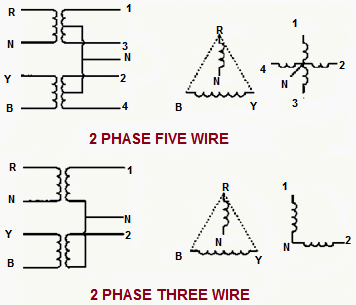Transforming 3 Phase to 2 Phase
There are two main reasons for the need to transform from three phases to two phases: to give a supply to an existing two phase system from a three phase supply and to supply two phase furnace transformers from a three phase source.

Two-phase systems can have 3-wire, 4-wire, or 5-wire circuits. It is needed to be considering that a two-phase system is not 2/3 of a three-phase system. Balanced three-wire, two-phase circuits have two phase wires, both carrying approximately the same amount of current, with a neutral wire carrying 1.414 times the currents in the phase wires.
The phase-to-neutral voltages are 90° out of phase with each other.
Two phase 4-wire circuits are essentially just two ungrounded single-phase circuits that are electrically 90° out of phase with each other.
Two phase 5-wire circuits have four phase wires plus a neutral; the four phase wires are 90° out of phase with each other.

The easiest way to transform three-phase voltages into two-phase voltages is with two conventional single-phase transformers. The first transformer is connected phase-to-neutral on the primary (three-phase) side and the second transformer is connected between the other two phases on the primary side.
The secondary windings of the two transformers are then connected to the two-phase circuit. The phase-to-neutral primary voltage is 90° out of phase with the phase-to-phase primary voltage, producing a two-phase voltage across the secondary windings. This simple connection, called the T connection, is shown in figure above.
The main advantage of the T connection is that it uses transformers with standard primary and secondary voltages.
The disadvantage of the T connection is that a balanced two-phase load still produces unbalanced three-phase currents; i.e., the phase currents in the three-phase system do not have equal magnitudes, their phase angles are not 120° apart, and there is a considerable amount of neutral current that must be returned to the source.
The Scott Connection of Transformer
A Scott-T transformer (also called a Scott connection) is a type of circuit used to derive two-phase power from a three-phase source or vice-versa. The Scott connection evenly distributes a balanced load between the phases of the source.
MAIN and Teaser outputs are on separate cores. An external jumper is also required to connect the primary side of the MAIN and Teaser sections.
The schematic of a typical Scott T Transformer is shown below:

Scott T Transformer is built with two single phase transformers of equal power rating. The MAIN and Teaser sections can be enclosed in a floor mount enclosure with MAIN on the bottom and Teaser on top with a connecting jumper cable. They can also be placed side by side in separate enclosures.
Assuming the desired voltage is the same on the two and three phase sides, the Scott-T transformer connection consists of a center-tapped 1:1 ratio main transformer, T1, and an 86.6% (0.5√3) ratio teaser transformer, T2. The center-tapped side of T1 is connected between two of the phases on the three-phase side. Its center tap then connects to one end of the lower turn count side of T2, the other end connects to the remaining phase.
The other side of the transformers then connects directly to the two pairs of a two-phase four-wire system.

The Scott-T transformer connection may be also used in a back to back T to T arrangement for a three-phase to 3 phase connection. This is a cost saving in the smaller kVA transformers due to the 2 coil T connected to a secondary 2 coil T in-lieu of the traditional three-coil primary to three-coil secondary transformer. In this arrangement the Neutral tap is part way up on the secondary teaser transformer .
The voltage stability of this T to T arrangement as compared to the traditional 3 coil primary to three-coil secondary transformer is questioned.
Key Points //
If the main transformer has a turn’s ratio of 1: 1, then the teaser transformer requires a turn’s ratio of 0.866: 1 for balanced operation.
Load connected between phaseY1 and phase Y2 of the secondary:
- Secondary current from the teaser winding into phase X1 = 1.0 < 90°
- Secondary current from the teaser winding into phase X2 = -1.0 < 90°
- Primary current from H3 phase into the teaser winding = 1.1547 < 90°
- Primary current from H2 phase into the main winding = 0.5774 < 90°
- Primary current from H1 phase into the main winding = -0.5774 < 90°
- The reason that the primary current from H3 phase into the teaser winding is 1.1547 due to 0.866: 1 turn’s ratio of the teaser, transforming 1/0.866= 1.1547 times the secondary current. This current must split in half at the center tap of the main primary winding because both halves of the main primary winding are wound on the same core and the total ampere-turns of the main winding must equal zero.
Load connected between phase X2 and phase X1 of the secondary:
- Secondary current from the main winding into phase X2 =1.0 < 0°
- Secondary current from the main winding into phase X4 = -1.0 < 0°
- Primary current from H2 phase into the main winding = 1.0 < 0°
- Primary current from H1 phase into the main winding = – 1.0 < 0°
- Primary current from H3 phase into the teaser winding = 0
- Superimpose the two sets of primary currents:
- I H3 = 1.1547 < 90° + 0 = 1.1547 < 90°
- I H2 = 0.5774 < 90° + 1.0 < 0° = 1.1547 < 30°
- I H1 = 0.5774 < 90°+ 1.0 < 0° = 1.1547 < 210°
Notice that the primary three-phase currents are balanced; i.e., the phase currents have the same magnitude and their phase angles are 120° apart. The apparent power supplied by the main transformer is greater than the apparent power supplied by the teaser transformer.
This is easily verified by observing that the primary currents in both transformers have the same magnitude; however, the primary voltage of the teaser transformer is only 86.6% as great as the primary voltage of the main transformer.
We also observe that while the total real power delivered to the two phase load is equal to the total real power supplied from the three-phase system, the total apparent power transformed by both transformers is greater than the total apparent power delivered to the two-phase load.
The apparent power transformed by the teaser is 0.866 X IH1= 1.0 and the apparent power transformed by the main is 1.0X IH2 =1.1547 for a total of 2.1547 of apparent power transformed.
The additional 0.1547 per unit of apparent power is due to parasitic reactive power owing between the two halves of the primary winding in the main transformer.
Single-phase transformers used in the Scott connection are specialty items that are virtually impossible to buy ‘‘off the shelf ’’ nowadays. In an emergency, standard distribution transformers can be used.
Advantages of the Scott T Connection //
If desired, a three phase, two phase, or single phase load may be supplied simultaneously. The neutral points can be available for grounding or loading purposes
Disadvantages when used for 3 Phase Loading //
This type of asymmetrical connection (3 phases, 2 coils), reconstructs three phases from 2 windings. This can cause unequal voltage drops in the windings, resulting in potentially unbalanced voltages to be applied to the load.
This design’s neutral has to be solidly grounded. If it is not grounded solidly, the secondary voltages could become unstable. Since this design will have a low impedance, special care will have to be taken on the primary protection fault current capacity. This could be an issue if the system was designed for a Delta-Star connection.
The inherent single phase construction and characteristics of this connection produces a comparatively bulky and heavier transformer when compared with a normal three phase transformer of the same rating.
Application
Main application is for For Industrial Furnace Transformer.
For Traction Purpose:
The power is obtained from the 220 kV or 132 kV or 110 kV or 66 kV, three-phase, effectively earthed transmission network of the State Electricity Board, through single-phase transformers or Scott connected transformer installed at the Traction Substation.
The primary winding of the single-phase transformer is connected to two phases of the transmission network or where Scott-connected transformer is used, the primary windings are connected to the three phases of the transmission network.
The single-phase transformers at a Traction Substation are connected to the same two phases of the transmission network (referred as single-phase connection), or alternatively to different pairs of phases- the three single phase transformers forming a delta-connection on the primary side.[/info_b0x]Out of three single-phase transformers, one transformer feeds the overhead equipment (OHE) on one side of the Traction Substation, another feeds the OHE on the other side of the Traction Substation, and the third remains as standby. Thus the two single-phase transformers which feed the OHE constitute an open-delta connection (alternatively, referred as V-connection) on the three-phase transformers network.
The Scott-connected transformer and V-connected single-phase transformers are effective in reducing voltage imbalance on the transmission network. The spacing between adjacent substations is normally between 70 and 100 km.











We have a commercial building storefront in Philadelphia that has existing two phase service from the utility company. We feel that the building only requires 120 volts, as there are no 240 volt applications on site. Can we just use two of the ungrounded conductors in one “single phase” panel and two in the other and share the grounded conductor? I feel this is obtainable and safe.
dear sir
can i show you SCOTT picture?
dear sir
in Scott-T connection convert 3-phase to 2-phase.in the output Y1 and X1 short then can use the Y2and X2 connete A 2 wire LOAD?
what is you say that
(Scott T Transformers require a three phase power input and provide two equal single phase outputs called Main and Teaser. The Main and Teaser outputs are 90 degrees out of phase. The MAIN and the Teaser outputs must not be connected in parallel or in series as it creates a vector current imbalance on the primary side.)
can you tell me more
Dear colleagues,
I have a question about the application of Scott transformer in traction systems to convert power from 230 kV to 25*25kV.
I want to know is there any practical project in which Scott transformer is used there?
Best regards
Yes it is used in Japanese shinkansen rail project
Hi,
1- Sir i want to know that a normal transformer (11kv/ 400V YnD11) can be converted in a Scott T Transformer?
2- How much rating of Scott T transformer are available.. I need 4 MVA Scott T Transformer.
Dear sir ,
Could you help me on any excell sheet that i can work on the calculation of substation loading for traction power .
Thanks
Rgds,
T.Sara
Am from Finmark Industries in ZIMBABWE, am working on a Tender for the Zimbabwe Power Co-operation for 2 x 90MVA Transformers, if you could forward me your email address then I can send you all the Documents.